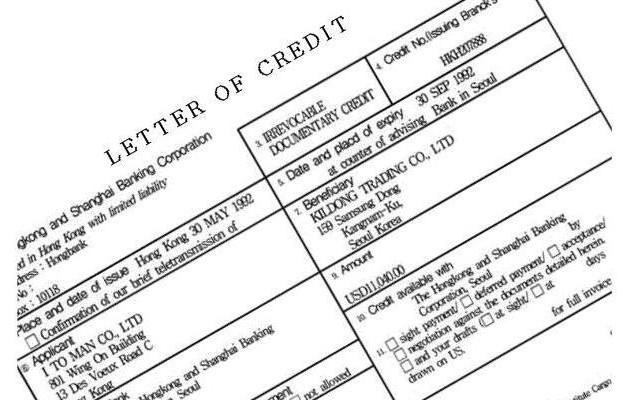In today's world, in the field of realizing all the advantages of building international business relations, such a tool as a letter of credit has become popular. Where is it used? What is it for? Read more about this and much more.
Role of letter of credit
This form of payment, which is gaining unprecedented momentum in the modern world, is used, as a rule, in international trade. First of all, it allows you to find a clear balance between the interests of exporters and buyers, that is, importers. Next, we will talk more about international letters of credit, their classification, and give samples.
The concept of international letter of credit
International letters of credit are contingent liabilities expressed in cash and applied by the issuing bank on behalf of the payer of the letter of credit in the global financial market. Their movement is regulated according to the "Unified Customs and Rules for Letters of Credit", as well as the "ICC Publication No. 500" (UCP500). In general, a letter of credit is a document agreement, after signing which the issuing bank undertakes, upon the request of the client (payer), to carry out the operation of paying for documents directly to a third party, that is, the beneficiary for whom the letter of credit was opened.

A bank obligation under a letter of credit is independent, independent of the relations of the parties in the legal field of validity of a commercial contract. This provision has been established with the aim of protecting banking and customer interests. The exporting party, in turn, ensures the creation of persistent restrictions on the requirements for paperwork and, accordingly, receipt of payments on the basis of existing conditions of the letter of credit, and the importer receives a guarantee that the conditions of this document will be met by the exporter.

From the above it follows that the letter of credit has a number of features that distinguishes it from the ordinary transaction of sale or commercial document, and also has the strength of the legal contract on which it is based.
Advantages and disadvantages of a letter of credit
Considering the concept of an international letter of credit, it is worth talking about the main advantages and disadvantages of this tool. Let's start with the positives:
- elimination of the risk of a situation when incorrect cash flows are created;
- elimination of insolvency risks;
- elimination of the possibility of changing the terms of the contract unilaterally after the conclusion of the transaction and, accordingly, the issuance of a letter of credit;
- elimination of cash loss risks;
- elimination of the possibility of violation of legal norms of one of the parties regulating a part of the contract for non-receipt of revenue in international payments currency that exist in relation to currency legislation;
- for participants it becomes possible to use a letter of credit in the system of related transactions as a means of financing commercial relations, as well as providing this financing;
- providing guarantees by virtue of the legal force of the document, as well as the fulfillment of all obligations in full by two parties;
- ensuring legal and documentary protection of the interests of the parties.

As for the cons, they look like this:
- difficulties with large volumes of documents at various stages of processing letters of credit;
- high costs for processing such forms of settlement for parties to a foreign trade transaction.
Letter of Credit Participants
The parties to the international letter of credit are the following entities:
- An applicant is a buyer who instructs his bank to open a letter of credit on the terms developed in their agreement.
- Issuing Bank - a financial institution that opens a letter of credit on behalf of the applicant and at his expense.
- Beneficiary - supplier (exporter), that is, the legal entity of the agreement receiving the letter of credit.
- Advice Bank - a bank whose purpose is to instruct in the form of settlements to notify in favor of the exporter the opening of a letter of credit and, accordingly, transmit the full text of the document.
- Executive Bank - performs payment transactions and has the authority to conduct such operations from the issuing bank.
- Confirming bank - in addition to the main provisions of the agreement, the list of obligations adds a letter of credit obligation under the terms of the agreement between financial institutions to make accredited payments.
- Transfer Bank - carries out letter of credit transfer operations on behalf of the beneficiary and is authorized to carry out such actions; this bank will be, respectively, and executive.

Types of letters of credit according to classification UCP500
There are many types of letters of credit depending on the role they play in all kinds of financial transactions, the interests of participants in these settlements, etc. Accordingly, there are no fewer modifications that are already assigned to one or another type of agreement.
First, we give a classification according to UCP500 standards (by default, a letter of credit subject to the main requirements of UCP500 is an open letter of credit):
- A revocable letter of credit is a form of settlement when the issuing bank has the opportunity to amend or cancel the terms of the contract without first informing the exporter. In practice, however, it is used extremely rarely.
- Standby letter of credit is bank guarantee used in cases of breach of obligations by counterparties under an international trade contract. However, due to the fact that this species is subject to the requirements of UCP500, it is subject to all the provisions regulated by these requirements without exception.
- Transferable letter of credit - a form of settlement in which the exporter asks the transferable bank to use a financial instrument by one or more other exporters.
- A confirmed letter of credit is a form of settlement, which, on behalf of the issuer, is confirmed by another financial institution. This institution has the same obligations as the issuer.
In practice, a huge number of payment forms are used, but they are not regulated by the UCP500 rules and financial institutions in which a letter of credit is open, as they are used in accordance with existing experience.

Huge distribution in the global financial market acquired letters of credit for the purchase of real estate. The parties reduce the risk of non-compliance with the terms of the contract using such a calculation form as a letter of credit. The property comes into the legal possession of the buyer only after the registration of the sale in state bodies.
Accounting letter of credit
It is also worth noting that when preparing financial statements, enterprises need to keep a correct record of transactions in international settlements and clearly see where the letter of credit is taken into account. Postings (in accounting) of letters of credit are carried out using account No. 55 “Special accounts” (subaccount 1).
Letter of credit implementation
Sale of a letter of credit - payment under a letter of credit agreement. A special role in this case is played by letters of credit when the bank branch is delegated the right to conduct payment operations abroad. Cases of the implementation of letters of credit:
- upon request, that is, when all the necessary documents are submitted;
- by acceptance, which are issued to a confirmed bank;

- with the help of negotiation: the negotiating bank pays the exporter the cost of the documents submitted (or undertakes to perform a payment operation) until receipt of settlement from the issuer.
Stages of the implementation of the letter of credit
There are several main stages in the implementation of a letter of credit:
- Preliminary: customers need to draw up the main provisions of the contract.
- An agreement is concluded between the parties.
- An instruction is given to the responsible importer’s bank to draw up an application for opening a letter of credit in the form of a bank for opening a letter of credit.
- Opening of a letter of credit.
- Monitoring the correctness of the letter of credit.
- The exporter fulfills the conditions for the provision of services or goods.
- Monitoring compliance of the content of contracts with the terms of the letter of credit.
- The bank reports the discrepancies found and returns the documentation for revision back to the exporter.
- Settlements under contracts on behalf of the bank.
- The bank transfers all documents to the importing company.

Letter of credit example
Below is a sample letter of credit for a better understanding of the functioning of this document.
| Amount
in words |
One hundred thirty five thousand rubles 00 kopecks | |||||
| TIN 6533018764 | Amount | 135000-00 | ||||
| Cf. No. | 33333444445555566666 | |||||
| Payer
LLC "Russian birch" |
||||||
| BIC | 012345678 | |||||
| Cf. No. | 99999888887777766666 | |||||
| Payer's bank
"Baltinvestbank" St. Petersburg |
||||||
| BIC | 076543212 | |||||
| Cf. No. | 55555666663333300000 | |||||
| payee's bank
"Alef-Bank" Moscow |
||||||
| TIN 0390564656 | Cf. No.
(40901) |
|||||
| View op. | 08 | Term valid. accreditation. | 05.12.2016 | |||
| Naz. pl. | ||||||
| Recipient
AOZT "Pole" |
Code | Res. field | ||||
| View
letter of credit |
irrevocable, uncovered | |||||
| Condition
payment |
without acceptance | |||||
| Names of goods, No. and date of contract, date of shipment of goods, consignee and destination | ||||||
| Submission payment (document type) | ||||||
| Additional terms | ||||||
| Account number the recipient | ||||||
This is what the letter of credit looks like. Signatures of competent persons and a wet seal are also placed below, a letter of credit number, type of payment and date of execution are indicated at the top.








